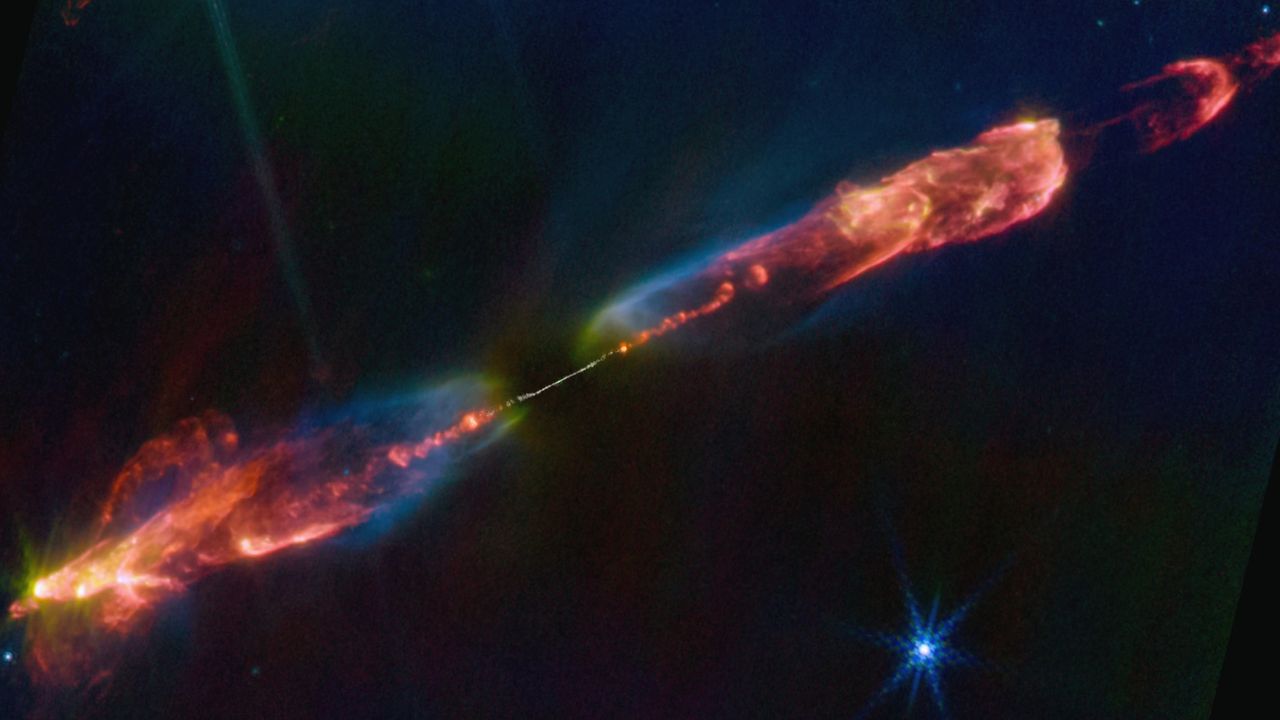Science
ALMA and JWST Unravel Star Formation Mystery in Stunning Image

A groundbreaking study utilizing the Atacama Large Millimeter/submillimeter Array (ALMA) and the James Webb Space Telescope (JWST) has provided new insights into the process of star formation. The research centers on a protostar known as HH 211, located approximately 1,000 light-years away in the constellation Perseus. This discovery, published on August 13, 2023, in the journal Scientific Reports, reveals the dynamics of energetic jets that play a crucial role in the growth of newborn stars.
Star formation, while a fundamental aspect of cosmic evolution, remains shrouded in mystery. Stars emerge from dense clouds of cold gas and dust. When these clouds accumulate sufficient mass, they collapse under their own gravity, resulting in the birth of a protostar. As these nascent stars form, they attract surrounding material, creating an accretion disk of gas and dust. The interaction within this disk is vital for the protostar’s growth.
One of the challenges in studying star formation is understanding the behavior of protostellar jets. These jets, which are streams of energized ionized material expelled from the protostar, are believed to facilitate the inflow of material from the accretion disk. Yet, observing these jets has proven difficult because they originate from regions close to the star. This study marks a significant advancement in capturing the dynamics of these jets.
Researchers focused on HH 211, a Herbig-Haro object that is only 35,000 years old. This protostar has a mass of just 0.06 times that of our sun and exhibits a prominent bipolar jet, with two beams of material ejecting in opposite directions. Notably, HH 211 is one of the few known systems where a magnetic field has been detected, providing an opportunity to explore how such fields influence jet formation.
The ALMA observations revealed that the jet is traveling at speeds of approximately 66 miles per second (107 kilometers per second) while rotating slowly. This observation indicates that the jet effectively transports excess rotational energy away from the protostar. By applying principles of angular momentum conservation, researchers determined that the jet originates from a region just 0.02 astronomical units, or nearly 1.85 million miles (3 million kilometers), from the protostar.
The data from ALMA, combined with the imagery from JWST, offers a comprehensive view of the star formation process. The colorful display of the bipolar jet captured in near-infrared wavelengths by JWST is juxtaposed with ALMA’s submillimeter data, which reveals the crucial inner region of the accretion disk. This collaboration provides the first visual evidence of protostellar jet launch locations, underscoring the jets’ role in star growth by removing angular momentum, thereby facilitating material infall.
This study not only enhances understanding of star formation but also highlights the capabilities of modern telescopes in unraveling cosmic mysteries. The collaboration between ALMA and JWST exemplifies how advanced technology can illuminate the processes that govern our universe.
As researchers continue to analyze this data, it is evident that HH 211 serves as a key example of how magnetic fields might assist in the formation of jets, potentially reshaping our understanding of star birth. The ongoing study promises to deliver further revelations about the intricate processes that lead to the formation of stars, a fundamental element in the evolution of the cosmos.
-

 Business1 week ago
Business1 week agoIconic Sand Dollar Social Club Listed for $3 Million in Folly Beach
-

 Health1 week ago
Health1 week agoPeptilogics Secures $78 Million to Combat Prosthetic Joint Infections
-

 Politics1 week ago
Politics1 week agoAfghan Refugee Detained by ICE After Asylum Hearing in New York
-

 Science1 week ago
Science1 week agoResearchers Achieve Fastest Genome Sequencing in Under Four Hours
-

 Lifestyle1 week ago
Lifestyle1 week agoJump for Good: San Clemente Pier Fundraiser Allows Legal Leaps
-

 Health1 week ago
Health1 week agoResearcher Uncovers Zika Virus Pathway to Placenta Using Nanotubes
-

 World1 week ago
World1 week agoUS Passport Ranks Drop Out of Top 10 for First Time Ever
-

 World1 week ago
World1 week agoRegional Pilots’ Salaries Surge to Six Figures in 2025
-

 Entertainment1 week ago
Entertainment1 week agoJennifer Lopez Addresses A-Rod Split in Candid Interview
-

 Science1 week ago
Science1 week agoMars Observed: Detailed Imaging Reveals Dust Avalanche Dynamics
-

 Top Stories6 days ago
Top Stories6 days agoChicago Symphony Orchestra Dazzles with Berlioz Under Mäkelä
-

 World1 week ago
World1 week agoObama Foundation Highlights Challenges in Hungary and Poland









